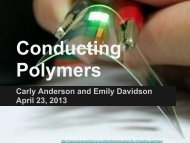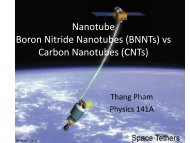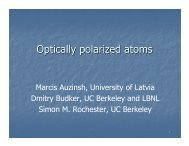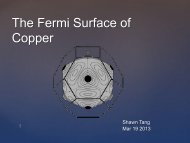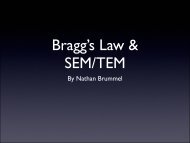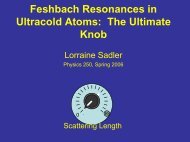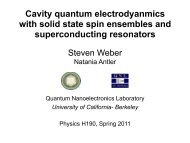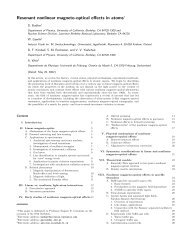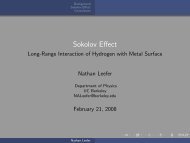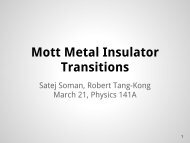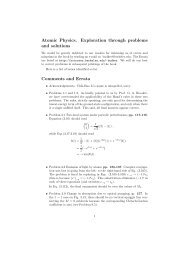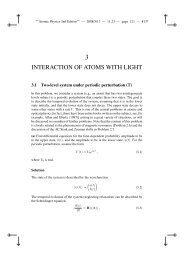Atomic Tests of Discrete Symmetries at Berkeley - The Budker Group
Atomic Tests of Discrete Symmetries at Berkeley - The Budker Group
Atomic Tests of Discrete Symmetries at Berkeley - The Budker Group
You also want an ePaper? Increase the reach of your titles
YUMPU automatically turns print PDFs into web optimized ePapers that Google loves.
its power, it is desirable to have a transverse-cavity-mode spot size which is as large<br />
as experimentally feasible. Unfortun<strong>at</strong>ely, as the cavity-mode size increases the cavity<br />
becomes more sensitive to misalignment and is less stable. Thus there is a practical<br />
limit on the size <strong>of</strong> a single cavity mode. Another approach th<strong>at</strong> we are pursuing is to<br />
use a confocal power-build-up cavity. In this case, each transverse mode is degener<strong>at</strong>e<br />
with either the fundamental transverse mode (with a different longitudinal index), or<br />
its eigenfrequency falls exactly between two fundamental modes [25]. Thus, instead <strong>of</strong><br />
coupling into just one transverse mode, it is possible to use a beam with a large spot size<br />
and excite many modes <strong>at</strong> once. <strong>The</strong> size <strong>of</strong> the ac-Stark shifts is the final quantity th<strong>at</strong><br />
must be measured before proceeding with the PNC experiment.<br />
In addition to the experiment described above we have investig<strong>at</strong>ed the possibility <strong>of</strong><br />
measuring the PNC effect in a vapor cell, which may allow for higher <strong>at</strong>omic densities<br />
and higher st<strong>at</strong>istical sensitivity [26, 27]. As with the <strong>at</strong>omic beam experiment the <strong>at</strong>oms<br />
would be excited in the presence <strong>of</strong> crossed electric and magnetic fields and a change<br />
in the transition r<strong>at</strong>e would be detected with a change in the handedness <strong>of</strong> the fields.<br />
<strong>The</strong> <strong>at</strong>oms undergoing the transition would be detected by using probe light <strong>at</strong> 649 nm<br />
resonant with a transition from the metastable 6s6p 3 P 0 st<strong>at</strong>e to a higher-lying 6s7s 3 S 1<br />
st<strong>at</strong>e. A possible limiting factor in this experiment is the collisional de-excit<strong>at</strong>ion <strong>of</strong><br />
the <strong>at</strong>oms in the metastable 6s6p 3 P 0 st<strong>at</strong>e by other Yb <strong>at</strong>oms as well as buffer gas<br />
<strong>at</strong>oms. We have measured the collisional perturb<strong>at</strong>ions <strong>of</strong> the 6s6p 3 P 0 st<strong>at</strong>e, including<br />
pressure broadening and de-excit<strong>at</strong>ion cross sections, due to quenching with possible<br />
buffer gases (He, Ne) and with Yb <strong>at</strong>oms [26]. <strong>The</strong>se experiments suggest th<strong>at</strong> indeed it<br />
may be possible to perform a Yb PNC experiment in a vapor cell with gre<strong>at</strong>er st<strong>at</strong>istical<br />
sensitivity than is possible with an <strong>at</strong>omic beam. However, there are many questions<br />
yet to be answered concerning the feasibility <strong>of</strong> such a measurement such as collisional<br />
broadening <strong>of</strong> the transition, ioniz<strong>at</strong>ion <strong>of</strong> the Yb <strong>at</strong>oms in the high-intensity light fields<br />
required for the experiment, and collisionally assisted transition r<strong>at</strong>es.<br />
Another possibility for a PNC experiment is an optical-rot<strong>at</strong>ion experiment in a vapor<br />
cell [28]. In this case the transition studied would be the M1 transition between the<br />
metastable 6s6p 3 P 0 st<strong>at</strong>e and the 6s6p 1 P 1 st<strong>at</strong>e. This transition amplitude is rel<strong>at</strong>ively<br />
large (≈ 0.1 µ B ) due to spin-orbit coupling. <strong>The</strong> PNC mixing described above again<br />
cre<strong>at</strong>es a E1 transition amplitude between st<strong>at</strong>es <strong>of</strong> nominally the same parity. <strong>The</strong><br />
interference between the M1 transition amplitude and the PNC-induced E1 transition<br />
amplitude leads to optical rot<strong>at</strong>ion <strong>of</strong> linearly polarized light in the absence <strong>of</strong> external<br />
fields. <strong>The</strong> magnitude <strong>of</strong> the optical rot<strong>at</strong>ion per unit absorption length is about an order<br />
<strong>of</strong> magnitude larger than in the transitions in Tl, Bi, and Pb, where this effect had<br />
been measured (this is partially due to a smaller M1 amplitude for Yb). Because the<br />
lower st<strong>at</strong>e is not the ground st<strong>at</strong>e, it is possible to measure spurious optical rot<strong>at</strong>ion by<br />
monitoring optical rot<strong>at</strong>ion as a function <strong>of</strong> time while the popul<strong>at</strong>ion <strong>of</strong> the 6s6p 3 P 0<br />
st<strong>at</strong>e decays. While quenching <strong>of</strong> the 6s6p 3 P 0 st<strong>at</strong>e in Yb-Yb collisions may be a<br />
limiting factor in this experiment, it appears possible th<strong>at</strong> a highly complementary<br />
measurement to Stark-interference measurements could be performed this way.



